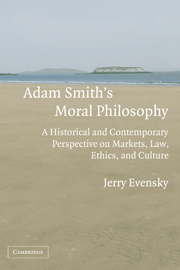 Adam Smith's Moral Philosophy
Adam Smith's Moral Philosophy Book contents
- Frontmatter
- Contents
- Preface
- Adam Smith's Moral Philosophy
- PART ONE ON ADAM SMITH'S MORAL PHILOSOPHICAL VISION
- PART TWO ON THE PLACE OF THE WEALTH OF NATIONS IN ADAM SMITH'S MORAL PHILOSOPHICAL VISION
- PART THREE ON ADAM SMITH'S MORAL PHILOSOPHICAL VISION AND THE MODERN DISCOURSE
- 10 “Chicago Smith” versus “Kirkaldy Smith”
- 11 Toward a Dynamic Three-Dimensional Analysis
- 12 The Liberal Plan and the Quandary of Capital
- Epilogue: On the Human Prospect
- References
- Index
11 - Toward a Dynamic Three-Dimensional Analysis
Published online by Cambridge University Press: 11 November 2009
- Frontmatter
- Contents
- Preface
- Adam Smith's Moral Philosophy
- PART ONE ON ADAM SMITH'S MORAL PHILOSOPHICAL VISION
- PART TWO ON THE PLACE OF THE WEALTH OF NATIONS IN ADAM SMITH'S MORAL PHILOSOPHICAL VISION
- PART THREE ON ADAM SMITH'S MORAL PHILOSOPHICAL VISION AND THE MODERN DISCOURSE
- 10 “Chicago Smith” versus “Kirkaldy Smith”
- 11 Toward a Dynamic Three-Dimensional Analysis
- 12 The Liberal Plan and the Quandary of Capital
- Epilogue: On the Human Prospect
- References
- Index
Summary
ANALYSIS IN TWO DIMENSIONS: THE NEW INSTITUTIONAL ECONOMICS
Oliver Williamson begins his September 2000 Journal of Economic Literature piece “The New Institutional Economics: Taking Stock, Looking Ahead” with the following reflection:
I open my discussion of the new institutional economics with a confession, an assertion, and a recommendation. The confession is that we are still very ignorant about institutions. The assertion is that the past quarter century has witnessed enormous progress in the study of institutions. The recommendation is that, awaiting a unified theory, we should be accepting of pluralism.
(Williamson, 595)The focus of Williamson's piece is on the progress he cites. My focus is on the ignorance.
Williamson represents society's institutional structure as having four levels. Level 1 encompasses the embedded “norms, customs, mores, [and] traditions” of society (Williamson, 596). Although these are institutionalized, they are not directly observable institutions. They are a “social stock of knowledge” (Berger and Luckmann, 42) that each new generation inherits and takes as representing the natural order of things, as tacit knowledge. Unlike a court system, a legislative system, a body of common law, or a constitution, one cannot examine this social construct directly. It is a substructure, an invisible foundation upon which all other institutions are constructed.
Level 2 of Williamson's social construction encompasses what Douglas North refers to as the “formal rules” of social organization, rules that include “constitutions, laws, [and] property rights” (North, 1991, 97).
- Type
- Chapter
- Information
- Adam Smith's Moral PhilosophyA Historical and Contemporary Perspective on Markets, Law, Ethics, and Culture, pp. 265 - 288Publisher: Cambridge University PressPrint publication year: 2005
